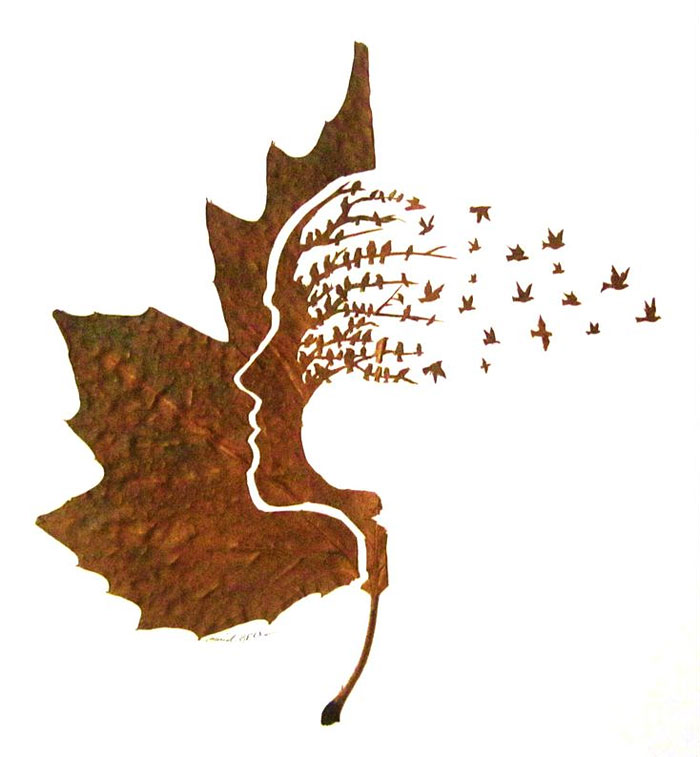A year ago, when I began this column, I thought I had a decent appreciation of a how versatile a sewing needle could be. Years of piercing fabric with this metal tool, carrying thread in its wake, made me aware of the needle’s ability to conjoin or decorate. In the kitchen I occasionally stitched up a turkey full of holiday stuffing. And of course, I was knew the needle’s value to other endeavors: tattoo parlors, hospital emergency/surgical units, acupuncture clinics, and voodoo séances. Motorized by a Mr. Singer, a needle could drive a whole industry. Still, in the course of this year, I have discovered that needles can do more, much more, particularly in the hands of an artist. Live and learn, as they say.
Needle as a Cutting Tool
Many an embroiderer has experience with how a sharp-pointed needle can cut the skin. An artist in Britain has applied that property extensively.
 |
| Leaf Art by Omid Asadi |
Omid Asadi, originally from Iran now of Manchester, uses a needle (and scalpel too) to coax images from fallen leaves that others would trample under foot. To Asadi an individual leaf suggests its subject: a portrait of a Bob Marley or Jimmy Hendrix, a rose in full bloom, or a phoenix rising from a split tree. He uses the deciduous leaf both as material and symbol. Life is short, he reminds interviewers.
Asadi’s approach is reminiscent of a sculptor, who releases figures trapped in a rude block of stone. His works are fine, delicate and often symbolic or whimsical. To me Asadi’s leaf cuttings are works of art for a combination of reasons: First they make me wonder at his leaps of vision/imagination. He creates “negative” space images, stencils really, preserving the shape of the leaf making the observer reconcile the two in his/her head. Then there is the sheer meticulous technical skill needed to liberate his vision, and finally, the depth of spirit he brings to his subject. A piece can take weeks or months to produce and is in constant danger of a fatal slip. As someone who stitches portraits over months I can relate to that!
Needle as a Frame
Needle as a Frame
No, I don’t mean a frame constructed of many needles soldered together. I mean the single hand sewing needle used to frame a piece of art.
English artist Willard Wigan uses the eye of a needle to support or frame his micro-figurines.
 |
| Sculpture by Willard Wigan framed in a needle |
Peering through a microscope, his sculpts grains of sand or rice with surgical blades or self-made tools rigged from tungsten filament, tipped by diamond chip. Wigan decorates works with dust fibers, gold even a spider’s web. To he paints figures, he devised bushes from the hairs of dead houseflies which he collects.
As a child Wigan, who suffers with dyslexia, had difficulties at school. This he explained in a TED talk, He felt small and invisible. His art grew from his need to counters the misconception that because something is small or hard to see, it isn’t there.
Wigan’s work, like Asadi’s requires great dexterity, patience, and discipline. Both artists are driven to elevate the mundane and unnoticed into something remarkable. Wigen’s work can take months to execute. You can be confident that no one fakes his work or Asadi!
Queen Elizabeth awarded Wigan an MBE. Prince Charles, Elton John, Simon Cowell, and Mike Tyson are among his collectors. Currently the Birmingham Library is displaying his work.
Needle in Performance Art
Late last year, I wrote about the Paris museum that turned the expression “Searching for a Needle in a Haystack” into performance art. The less said about that experiment the better. But if you must, click here to read what I said then. The idea has not improved with time. Nor have I changed my point of view.
In the meantime, if anyone out there has found new uses for a needle, I would be delighted to hear about them!

.JPG)
.jpg)
(1).JPG)
.jpg)

